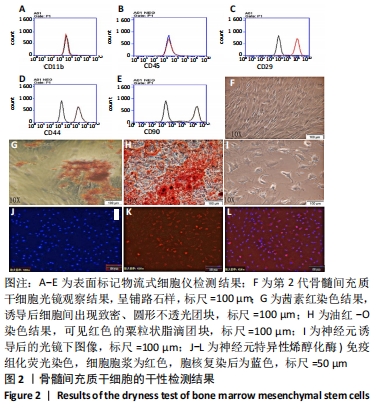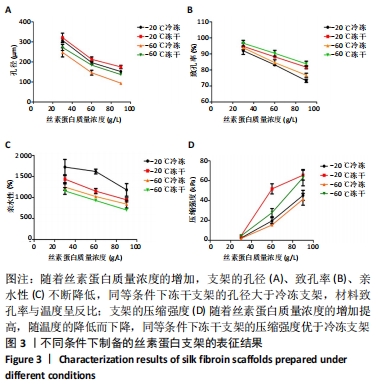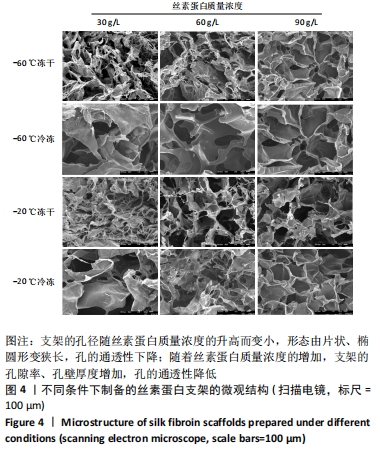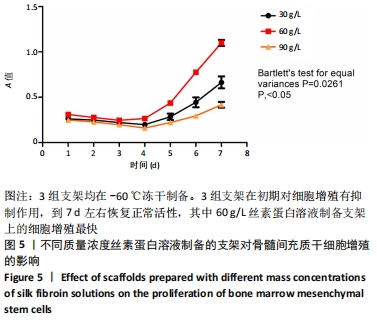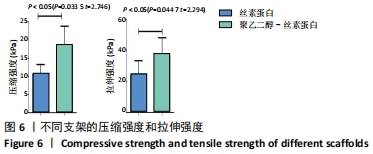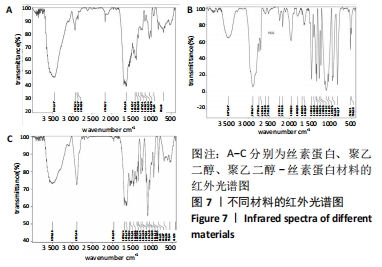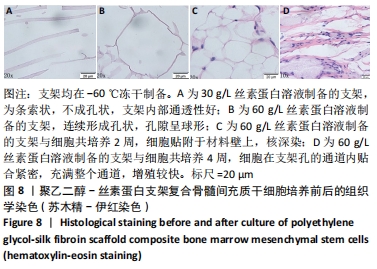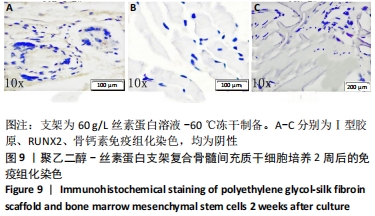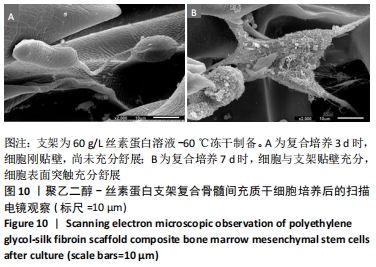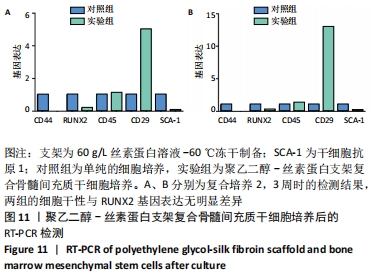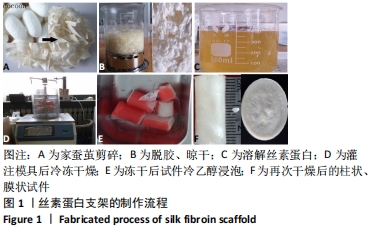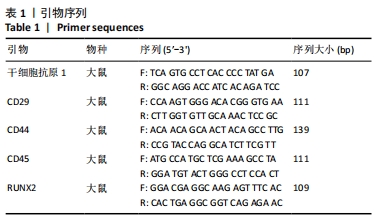中国组织工程研究 ›› 2022, Vol. 26 ›› Issue (16): 2545-2550.doi: 10.12307/2022.255
• 组织工程骨材料Tissue-engineered bone • 上一篇 下一篇
丝素蛋白构建骨组织工程多孔支架制作条件的选择
杨兴华1,2,张 静3,陈岱韻1,熊世江2
- 1山东第一医科大学(口腔医学院),山东省泰安市 271000;2山东大学口腔医学院,山东省济南市 250012;3滕州市中心人民医院口腔科,山东省滕州市 277500
Selection of conditions for fabricated porous scaffolds in bone tissue engineering by silk fibroin protein
Yang Xinghua1, 2, Zhang Jing3, Chen Daiyun1, Xiong Shijiang2
- 1School of Stomatology, Shangdong First Medical University, Tai’an 271000, Shandong Province, China; 2School of Stomatology, Shandong University, Jinan 250012, Shandong Province, China; 3Department of Stomatology, Tengzhou Center Renmin Hospital, Tengzhou 277500, Shandong Province, China
摘要:
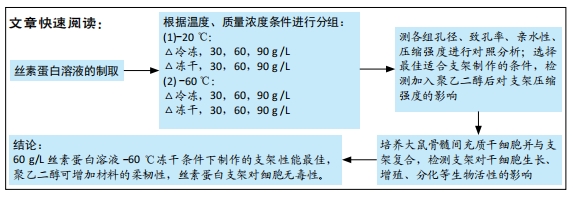
文题释义:
家蚕丝素蛋白:是家蚕丝的主要组成成分,为天然高分子纤维蛋白,含量占蚕丝的70%-80%,含有18种氨基酸。丝素蛋白本身具有良好的机械性能和理化性质,如良好的柔韧性和抗拉伸强度、透气透湿性、缓释性等,而且经过不同处理可以得到不同的形态,如纤维、溶液、粉、膜以及凝胶等。
骨组织工程支架材料:是指能与组织活体细胞结合并能植入生物体具有替代骨组织功能的材料。材料应具有:合适的孔径和孔隙率,骨传导性和骨诱导性,生物相容性和表面活性,机械强度和可塑性。
背景:丝素蛋白支架的致孔技术多采用冷冻或者冷冻干燥法制取,但不同浓度、温度等条件对支架的物理生物性能有影响,对骨组织支架的制取采用何种冷冻方式、哪种浓度尚无明确的专题研究。
目的:研究水致孔条件下丝素蛋白溶液质量浓度、冷冻条件、10 g/L聚乙二醇对丝素蛋白支架属性的影响,选择适合骨组织工程支架的制作条件。
方法:制备30,60,90 g/L的丝素蛋白溶液,-20 ℃预冷冻后每种质量浓度的丝素蛋白溶液分4组处理,制备多孔支架:-20 ℃冷冻处理组、-60 ℃冷冻处理组、-20 ℃冻干处理组、-60 ℃冻干处理组。测定各组支架的孔径、亲水性、致孔率、压缩强度与细胞相容性,扫描电镜下观察支架的微观结构,通过以上结果获得制备多孔支架的最佳冷冻条件与丝素蛋白溶液质量浓度。将聚乙二醇与60 g/L的丝素蛋白溶液混合均匀,-60 ℃冻干处理制备丝素蛋白多孔支架,检测复合支架的压缩强度、拉伸强度与细胞相容性。
结果与结论:①由孔径、亲水性、致孔率、压缩强度与细胞相容性实验结果可知,60 g/L丝素蛋白溶液经-20 ℃预冷冻后再经-60 ℃冻干处理可获得最佳的多孔支架,该支架的孔径为(213.07±37.89) µm、孔致率为85%,可促进骨髓间充质干细胞的增殖。②加入聚乙二醇可提升丝素蛋白支架的压缩强度与拉伸强度(P < 0.05)。③将骨髓间充质干细胞接种于聚乙二醇-丝素蛋白复合支架上,共培养7 d的扫描电镜显示细胞与支架贴壁充分,细胞表面突触充分舒展;共培养2周时的苏木精-伊红染色显示,细胞贴附于支架壁上,核深染,4周时细胞在支架孔的通道内贴合紧密,充满整个通道,增殖较快;共培养2周的免疫组化染色显示,Ⅰ型胶原、RUNX2、骨钙素呈阴性表达;共培养3周的RT-PCR检测显示,复合支架对骨髓间充质干细胞的分化无影响。④结果表明,-60 ℃条件下60 g/L的丝素蛋白溶液经冷冻干燥制作的多孔支架较适合骨组织工程使用,10 g/L的聚乙二醇可提升支架的拉伸和压缩强度,该支架对细胞分化无诱导作用。
https://orcid.org/0000-0001-7256-5383 (杨兴华)
中国组织工程研究杂志出版内容重点:生物材料;骨生物材料; 口腔生物材料; 纳米材料; 缓释材料; 材料相容性;组织工程
中图分类号:
